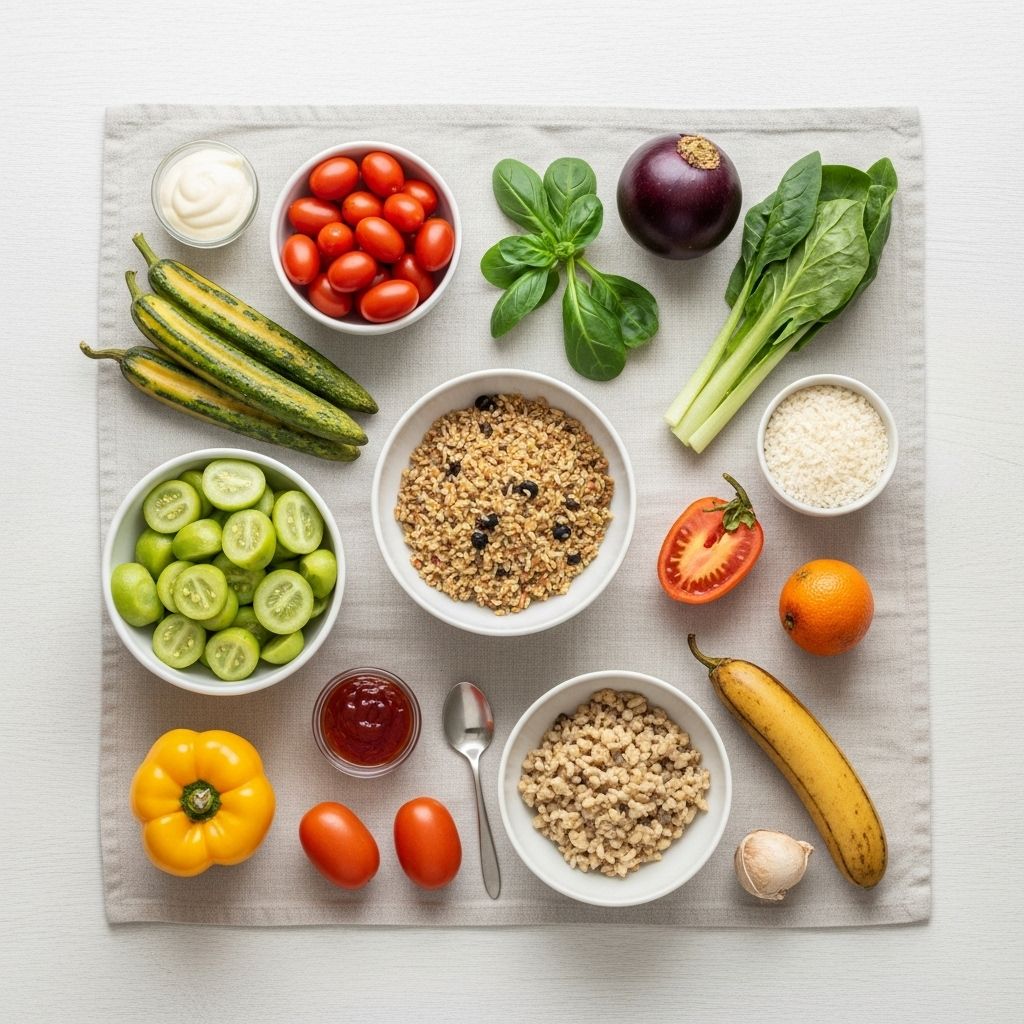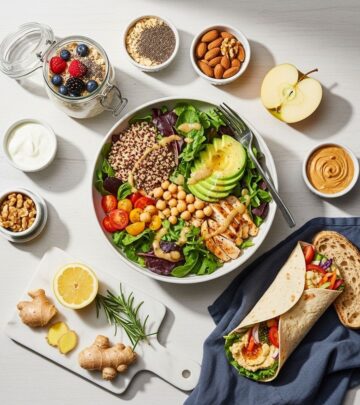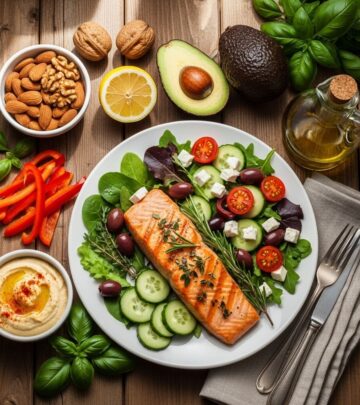30-Day Low-Added-Sugar High-Fiber Anti-Inflammatory Meal Plan
A nutritionist-designed month of meals packed with fiber, low in added sugar, and rich in foods that combat inflammation

Welcome to a 30-Day Nutritional Reset
In today’s world, dietary patterns often lead to excessive sugar consumption and insufficient fiber, both linked to chronic health issues and inflammation. The 30-Day Low-Added-Sugar High-Fiber Anti-Inflammatory Meal Plan is designed by nutrition professionals as a science-backed, actionable approach to supporting your wellbeing—offering a month of balanced, delicious meals and snacks to help you feel your best.
Why This Meal Plan Matters
Many individuals consume much more added sugar than health guidelines recommend—sometimes over 17 teaspoons daily, well beyond American Heart Association limits. At the same time, most people fall far short of the recommended daily fiber intake, which is essential for digestive health, stable energy, and reduced inflammation.
This plan is tailored to help you break unhealthy habits, focusing on foods naturally low in added sugars and high in fiber, while emphasizing nutrients known to quiet inflammation, such as those found in richly pigmented fruits, vegetables, nuts, healthy fats, and fish.
Key Benefits
- Helps lower daily intake of added sugar, reducing risk for obesity, diabetes, and heart disease
- Delivers at least 33–44 grams of fiber per day—far above the national average
- Includes anti-inflammatory foods shown to support long-term health
- Offers calorie-appropriate modifications (1,500, 1,800, and 2,000 calories per day)
- Provides at least 76 grams of protein daily for satiety and muscle maintenance
Understanding the Core Principles
No Added Sugar
Unlike many modern diets, this plan contains scarcely any added sugars, relying instead on the natural sweetness of fruits and the savory qualities of whole foods. Occasional desserts feature honey or maple syrup in moderation, but refined sugar is virtually absent.
High Fiber Focus
Fiber is abundant—think whole grains, legumes, vegetables, fruits, nuts, and seeds. Daily fiber goals exceed 30 grams, supporting gut health, stable blood sugar, and reduced inflammation. This nutrient is also closely tied to feelings of fullness, helping curb unnecessary snacking.
Anti-Inflammatory Power
Chronic inflammation is increasingly linked to heart disease, diabetes, and even certain cancers. This plan includes foods with known anti-inflammatory properties: leafy greens, berries, fatty fish, nuts, olive oil, and spices like turmeric and ginger.
What’s on the Menu?
Each day is carefully structured with breakfast, morning snack, lunch, afternoon snack, dinner, and sometimes an evening snack. Here’s a glimpse into a typical day:
Sample Day: Breakdown
| Meal | Calories | Example |
|---|---|---|
| Breakfast | ~360–435 | Greek yogurt with toasted oats, raspberries, walnuts |
| Morning Snack | ~100–300 | Apple with almond butter |
| Lunch | ~420–538 | Quinoa salad with chickpeas, veggies, olive oil dressing |
| Afternoon Snack | ~35–203 | Carrot sticks with hummus |
| Dinner | ~406–628 | Roasted salmon, roasted Brussels sprouts, brown rice |
| Evening Snack (optional) | ~95 | Dark chocolate with almonds |
Calorie adjustments are straightforward: omit snacks to reduce calories; add nutrient-dense items (like avocado toast or a smoothie) to increase them.
Week-by-Week Meal Plan Overview
For this 30-day plan, each week features a variety of meals to prevent boredom and ensure a broad spectrum of nutrients. Below is a condensed weekly summary.
Week 1 Highlights
- Breakfast: Oatmeal with berries and nuts, smoothies with flaxseed
- Lunch: Grain bowls, hearty salads with beans and seeds
- Dinner: Fish or plant-based proteins, roasted vegetables, whole grains
- Snacks: Fresh fruit, nuts, veggie sticks with hummus
Daily fiber intake starts strong, with at least 40 grams on many days.
Weeks 2–4: Rotation and Variety
The plan rotates ingredients and cooking methods to keep meals interesting. Expect:
- Stuffed peppers, lentil soups, and stir-fries
- Creative salads with kale, quinoa, and avocado
- Homemade dressings with olive oil, lemon, and herbs
- Fish at least twice weekly for omega-3s
- Desserts featuring dark chocolate, nuts, and fresh fruit
Week 5: Final Stretch
By the end of the month, the plan reinforces sustainable habits with:
- Breakfasts like peanut butter-banana flaxseed smoothies
- Lunches such as black bean and sweet potato bowls
- Dinners including grilled chicken with roasted vegetables
- Snacks that are simple and satisfying, like a handful of almonds or an orange
Even on the final days, sugar intake remains minimal, and fiber stays high.
Nutritional Breakdown
Each day’s menu is meticulously balanced. Here’s a snapshot of average daily nutrition for the 1,800-calorie plan:
| Nutrient | Average Amount |
|---|---|
| Calories | ~1,800 |
| Protein | 76–98g |
| Fiber | 33–44g |
| Total Sugar | 40–106g (mostly natural) |
| Added Sugar | 0–5g |
| Fat | 78–102g (mostly unsaturated) |
| Sodium | 1,279–1,776mg |
Calorie modifications (1,500 or 2,000) are clearly outlined for each day, making the plan adaptable for different needs.
Sample Recipes
Here are a couple of standout recipes to give you a taste of the plan’s approach.
Cinnamon-Toasted Oats with Yogurt and Berries
- 1 cup low-fat plain Greek yogurt
- 1 serving cinnamon-toasted oats (rolled oats toasted with cinnamon)
- ½ cup raspberries
- 2 Tbsp chopped walnuts
Combine all ingredients for a satisfying, protein- and fiber-rich breakfast.
Watermelon-Peach Smoothie
- 1 cup watermelon cubes
- 1 medium peach
- ½ cup plain kefir or yogurt
- 1 Tbsp flaxseed
Blend until smooth for a refreshing, fiber-filled snack.
Key Foods to Embrace
- Vegetables: Leafy greens, Brussels sprouts, carrots, sweet potatoes
- Fruits: Berries, apples, oranges, peaches, watermelon
- Whole Grains: Oats, quinoa, brown rice, whole wheat
- Legumes: Chickpeas, black beans, lentils
- Healthy Fats: Olive oil, avocado, nuts, seeds
- Protein: Fatty fish, chicken, tofu, Greek yogurt
- Spices: Turmeric, ginger, cinnamon, black pepper
Foods to Limit or Avoid
- Foods with added sugars (sodas, candy, pastries, sweetened yogurts)
- Refined grains (white bread, white rice, regular pasta)
- Processed meats and fried foods
- Excess salt and savory snacks
Tips for Success
- Meal Prep: Spend a few hours each week prepping ingredients to make daily cooking easier.
- Stay Hydrated: Drink plenty of water—sometimes thirst is mistaken for hunger.
- Listen to Your Body: Adjust portion sizes based on your hunger and activity levels.
- Add Variety: Rotate recipes to keep meals exciting and ensure a wide range of nutrients.
- Read Labels: Be vigilant about added sugars in packaged foods, even those marketed as healthy.
Frequently Asked Questions (FAQs)
Is this plan suitable for vegetarians or vegans?
Yes, the plan is easily adaptable. Swap animal proteins for plant-based options like tofu, tempeh, or additional legumes.
Can I follow this plan if I have diabetes?
This plan’s high fiber and low added sugar approach is generally supportive for blood sugar management, but always consult your healthcare provider before starting any new diet.
How do I adjust the plan for weight loss or weight gain?
Calorie modifications are built in. For weight loss, follow the 1,500-calorie option; for weight gain, use the 2,000-calorie version. Adjust snacks and portions as directed.
What if I don’t like a certain food?
Feel free to swap similar foods. For example, replace salmon with another fatty fish or walnuts with another nut or seed.
How do I make sure I get enough protein?
Protein sources are included at every meal, but you can always add an extra serving of Greek yogurt, nuts, or legumes if needed.
Is it okay to have dessert?
Occasional desserts with natural sweeteners like dark chocolate, fruit, or a small amount of honey are included without derailing the plan’s goals.
Conclusion
This 30-day low-added-sugar, high-fiber, anti-inflammatory meal plan is a science-backed blueprint for better health. By emphasizing whole, minimally processed foods and avoiding added sugars, it supports digestion, heart health, stable energy, and a lower risk of chronic disease. With clear calorie options, adaptable recipes, and a focus on delicious variety, it’s a sustainable way to reset your eating habits and nourish your body for the long term.
Read full bio of Sneha Tete












